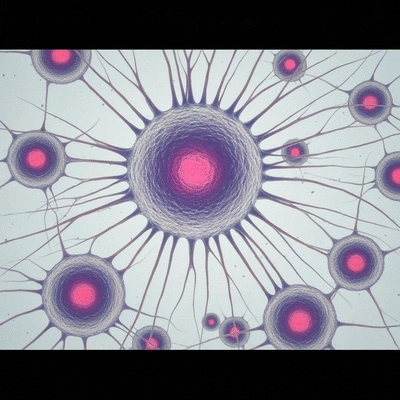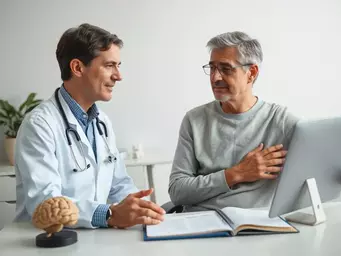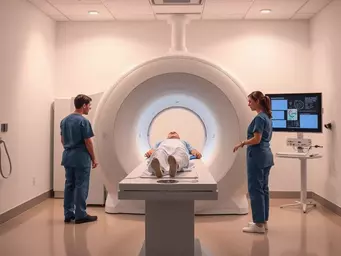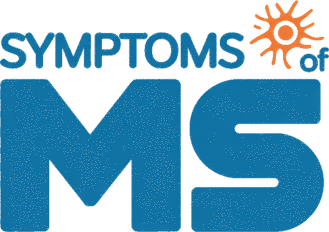Understanding Stem Cell Therapy for MS

Every decision you make about your health should be informed, especially when it involves groundbreaking treatments like Autologous Hematopoietic Stem Cell Transplantation (AHSCT) for multiple sclerosis. Are you ready to take charge of your healthcare journey?
What You Will Learn
- AHSCT has the potential to significantly improve the quality of life for patients with aggressive forms of MS.
- Understanding the eligibility criteria can help you assess if you are a suitable candidate for this treatment.
- Discussing the procedure, risks, and expected outcomes with your healthcare provider is crucial.
- Post-transplant care and lifestyle adjustments play a critical role in recovery.
The AHSCT Process and Patient Suitability
This visual outlines the key steps involved in Autologous Hematopoietic Stem Cell Transplantation (AHSCT) for Multiple Sclerosis and the characteristics that define an ideal candidate for this treatment.
AHSCT Process Flow
- Stem cells harvested from patient.
- Chemotherapy to suppress immune system.
- Harvested stem cells reinfused.
- New immune system rebuilds.
Ideal AHSCT Candidate Criteria
- Aged 18-65 years.
- Diagnosed with Relapsing-Remitting MS (RRMS).
- Significant disease activity despite prior treatment.
- Overall good health status.
Understanding Autologous Hematopoietic Stem Cell Transplantation (AHSCT) for Multiple Sclerosis
As someone deeply invested in the world of multiple sclerosis (MS), I often find myself discussing innovative treatments like Autologous Hematopoietic Stem Cell Transplantation (AHSCT). This approach has garnered attention for its potential to reset the immune system and halt disease progression. But how exactly does it work? Let's explore the fundamentals of AHSCT and its implications for MS treatment.
What is Stem Cell Therapy for MS and How Does AHSCT Work?
AHSCT is a form of stem cell therapy that utilizes hematopoietic stem cells—cells in the bone marrow responsible for producing blood cells. The therapy involves collecting these stem cells from the patient, followed by a conditioning regimen that prepares the body for transplantation. The goal is to eliminate the existing immune cells that are attacking the nervous system in MS, allowing the body to regenerate a healthier immune system. Research, such as a study on AHSCT's impact on neuroinflammation in MS, continues to shed light on its mechanisms and efficacy.
- Step 1: Stem cells are harvested from the patient's blood or bone marrow.
- Step 2: The patient undergoes chemotherapy to suppress their immune system.
- Step 3: Once the immune cells are reduced, the harvested stem cells are reinfused into the patient.
- Step 4: The body begins to produce new blood cells and rebuild a healthier immune system.

This process is critical as it helps to reset the immune response, thus potentially stopping the autoimmune attack on the central nervous system associated with MS. The hope is that, with a renewed immune system, patients experience fewer flare-ups and improved overall health.
Why Consider AHSCT for Multiple Sclerosis?
Many patients are drawn to AHSCT because of its potential to significantly alter the course of MS. Here are some compelling reasons to consider this treatment:
- It can potentially halt disease progression, especially in aggressive forms of MS.
- Many patients report improvements in their quality of life.
- AHSCT may reduce the frequency and severity of relapses.
In my experience, patients often express hope when discussing AHSCT. They see it not only as a treatment option but as a chance to regain control over their health. While not everyone may be a candidate, those who qualify might find AHSCT to be a transformative journey.
Understanding the Immune System's Role in MS Treatment
The immune system plays a pivotal role in multiple sclerosis, as MS is fundamentally an autoimmune disease where the body mistakenly attacks its own tissues. Through AHSCT, we aim to address this dysfunction. By reintroducing new hematopoietic stem cells, we effectively reset the immune system's behavior. An early-stage trial has shown promise for treating progressive MS with stem cell therapy, highlighting the potential of this approach.
It's essential to understand that AHSCT doesn't cure MS, but it can significantly improve the prognosis for many patients. The new immune system, ideally, would no longer target the myelin sheath surrounding nerves. This shift can lead to a reduction in symptoms and an overall enhancement in life quality.
Eligibility Criteria for AHSCT: Who is the Right Candidate?
Characteristics of Ideal Candidates for AHSCT
When considering AHSCT, specific characteristics make some patients more suitable than others. Typically, the ideal candidate for AHSCT includes:
- Aged between 18 and 65 years
- Diagnosed with relapsing-remitting MS (RRMS)
- Experiencing significant disease activity despite treatment
In my practice at Symptoms of MS, I emphasize the importance of evaluating a patient's unique situation. Each individual's condition and response to previous treatments play a crucial role in determining if AHSCT is a viable option for them.
Assessing Risks and Benefits for Potential Patients
As with any medical procedure, it's important to weigh the risks and benefits of AHSCT. Patients often ask about potential complications and expected outcomes. Here are the key factors to consider:
- Possible side effects include infection, bleeding, and complications from chemotherapy.
- However, many patients experience significant long-term benefits, including reduced disabilities.
- It's vital to have a thorough discussion with healthcare providers to understand individual risks.

Being informed is empowering. As someone who is passionate about educating others on MS, I encourage patients to gather as much information as possible before making any decisions regarding AHSCT.
Patient Eligibility: Who Can Undergo AHSCT?
Determining eligibility for AHSCT involves a comprehensive assessment. Healthcare teams will evaluate:
- Overall health status and comorbidities
- Type and stage of MS
- Response to previous treatments
This thorough evaluation ensures that only those who can benefit from AHSCT proceed with the treatment. I believe that every patient deserves a personalized approach, and this assessment process is a crucial step in their journey with MS.
Pro Tip
Did you know? Engaging with support groups and communities can greatly enhance your understanding of AHSCT and provide emotional support. Sharing experiences with others who have undergone the treatment can offer valuable insights and encouragement as you navigate your own journey with MS.
Frequently Asked Questions About AHSCT for MS
Q1: What is Autologous Hematopoietic Stem Cell Transplantation (AHSCT)?
AHSCT is a type of stem cell therapy for multiple sclerosis that involves harvesting a patient's own hematopoietic stem cells, undergoing chemotherapy to suppress the immune system, and then reinfusing the harvested cells to rebuild a new, healthier immune system that no longer attacks the central nervous system.
Q2: Who is an ideal candidate for AHSCT for MS?
Ideal candidates are typically between 18 and 65 years old, diagnosed with relapsing-remitting MS (RRMS), have significant disease activity despite prior treatments, and are in overall good health.
Q3: What are the main benefits of AHSCT for MS?
AHSCT can potentially halt disease progression in aggressive forms of MS, improve patients' quality of life, and reduce the frequency and severity of relapses.
Q4: What are the risks associated with AHSCT?
Potential risks include infection, bleeding, and complications from chemotherapy. It's crucial to discuss these thoroughly with healthcare providers.
Q5: Does AHSCT cure multiple sclerosis?
AHSCT does not cure MS, but it can significantly improve the prognosis and quality of life for many patients by resetting the immune system to reduce autoimmune attacks on myelin.
Q6: What role does the immune system play in MS and AHSCT?
MS is an autoimmune disease where the immune system attacks its own tissues. AHSCT aims to reset the immune system's behavior, preventing it from targeting the myelin sheath and thereby reducing symptoms and enhancing life quality. For further reading, an article in PMC discusses the complexities of immune reconstitution after AHSCT.
Summarizing Key Takeaways for Patients Considering AHSCT
As we explore the complex world of Autologous Hematopoietic Stem Cell Transplantation (AHSCT) for multiple sclerosis (MS), it’s essential to recap the critical points that can guide your decision-making process. Understanding the benefits and risks associated with AHSCT is key to navigating this treatment option effectively. From its potential to halt disease progression to the importance of patient selection, taking these insights into account can empower you to make informed choices about your health.
Here are some key takeaways to remember when considering AHSCT:
- AHSCT offers the potential to significantly improve quality of life for patients with aggressive forms of MS.
- Understanding the eligibility criteria can help you assess if you are a suitable candidate for this treatment.
- Discussing the procedure, risks, and expected outcomes with your healthcare provider is crucial.
- Post-transplant care and lifestyle adjustments play a critical role in recovery.
Empowering Patients: Seeking Support and Making Informed Decisions
As a neurologist deeply invested in patient education, I encourage you to take an active role in your healthcare journey. Consulting with healthcare professionals who specialize in MS can provide valuable insights tailored to your unique situation. Connecting with support groups and MS communities can also be beneficial. These networks foster a shared understanding and can offer emotional support as you navigate the complexities of your treatment options.
Don’t hesitate to ask questions! A well-informed patient is an empowered patient. Seek out resources that can help clarify any uncertainties surrounding AHSCT and its implications. Together with your healthcare team, you can create a comprehensive plan that addresses your concerns and aspirations.
Call to Action: Further Research and Patient Advocacy
Staying informed about ongoing research and clinical trials is vital for anyone considering AHSCT. I encourage you to explore reliable sources of information related to emerging therapies and advancements in treatment. Advocacy groups can also play a significant role in your journey by sharing updates on patient rights and opportunities for involvement in clinical studies.
By participating in discussions and staying abreast of new findings, you not only enhance your understanding but also contribute to the broader MS community. Your voice matters, and advocating for yourself and others can lead to positive changes in the treatment landscape.
Patient Experiences: Real Stories from AHSCT Recipients
Hearing from others who have undergone AHSCT can be incredibly inspiring and informative. Many patients share their journeys, detailing their challenges and triumphs post-transplant. These real stories often highlight the resilience of individuals facing MS and the transformative potential of AHSCT.
As you consider this treatment option, I recommend looking for testimonials and experiences shared by AHSCT recipients. They can offer invaluable insights into the decision-making process, the treatment experience, and the outcomes. Remember, you are not alone in this journey; the MS community is here to support you every step of the way.
Recap of Key Points
Here is a quick recap of the important points discussed in the article:
- AHSCT has the potential to significantly improve quality of life for patients with aggressive forms of MS.
- Understanding the eligibility criteria is crucial for assessing suitability for this treatment.
- Engaging in thorough discussions with healthcare providers about the procedure, risks, and expected outcomes is essential.
- Post-transplant care and necessary lifestyle adjustments are key to successful recovery.









